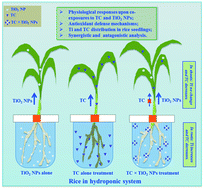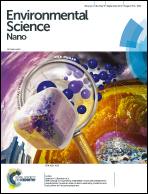Effects of titanium oxide nanoparticles on tetracycline accumulation and toxicity in Oryza sativa (L.)†
Abstract
Although both antibiotic residues and metal-based nanoparticles (NPs) are common emerging pollutants, little is known about their potential co-contaminant interactions, including resulting impacts on sensitive biota such as food crops. This study assessed the impact of tetracycline (TC, 5–20 mg L−1) and titanium dioxide (TiO2, 500–2000 mg L−1) NPs co-exposure on rice (Oryza sativa L.) under a 10 d hydroponic exposure. Plant biomass, contaminant content (TC, Ti), oxidative stress enzymes, and macro-/micronutrient contents were measured in rice shoots and roots as a function of exposure. Under TC alone exposure, dose-dependent toxicity (biomass, oxidative stress enzymes) and TC accumulation were observed and the levels of several key elemental nutrients were decreased. For example, root biomass treated with 5 and 20 mg L−1 TC was reduced by 18.8% and 62.5%, respectively, relative to the control. The contents of K, P, and S in 10 and 20 mg L−1 TC treated rice shoots were approximately 80% of the unamended control. Under co-exposure, the presence of TiO2 NPs significantly enhanced the TC treated rice growth in terms of plant size and total biomass. In addition, TiO2 NPs significantly reduced the levels of TC in rice shoots and roots, as well as oxidative stress enzymes, back to the level of unamended controls and also enabled recovery of TC-induced nutrient deficiency. It is worth mentioning that both contaminants resulted in severe iron deficiency (44–76% decreases of Fe in all the treatments were evident) under both single and co-exposure treatments. Abiotic sorption data indicates that TC phytotoxicity was prevented due to sorption of the antibiotic onto NP TiO2 (a maximum amount was 2.62 mg g−1), resulting in significantly decreased availability to the rice seedlings. The presence of TC increased the Ti content in rice roots, which could be ascribed to the alteration of surface charges of TiO2 NPs as affected by TC. Antagonistic and synergistic effects of TiO2 NPs and TC on rice were analyzed using three methods, including toxicity unit (TU), additional index (AI), and mixture toxicity index (MTI), all of which indicated under co-exposing condition, TiO2 NPs and TC interacted antagonistically, resulting in an overall alleviation of phytotoxicity and enhanced plant health.



 Please wait while we load your content...
Please wait while we load your content...